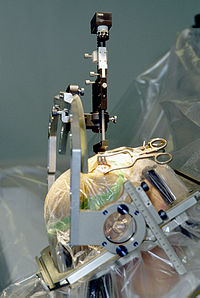
Photo from wikipedia
OBJECTIVES Br(E)-MsEP monitoring is widely used in spinal surgery for detection of spinal cord injury. However, Br(E)-MsEP waveform derivation requires high-intensity stimulation, and this raises a concern of adverse effects… Click to show full abstract
OBJECTIVES Br(E)-MsEP monitoring is widely used in spinal surgery for detection of spinal cord injury. However, Br(E)-MsEP waveform derivation requires high-intensity stimulation, and this raises a concern of adverse effects due to the immature corticospinal tract in pediatric patients. The purpose of this study is to determine the optimal stimulation intensity required for derivation of Br(E)-MsEP waveforms at baseline in pediatric spinal surgery. PATIENTS AND METHODS The subjects were 85 pediatric patients (4-15 years old, mean age at surgery: 11.1 years old) who were treated with spinal surgery using a posterior only approach under Br(E)-MsEP monitoring. The main diagnoses were adolescent idiopathic scoliosis (n = 44), syndromic and neuromuscular scoliosis (n = 23), and congenital scoliosis (n = 12). A total of 1513 muscles in the lower extremities were chosen for monitoring. RESULTS A baseline waveform was obtained in all 85 cases and baseline Br(E)-MsEP responses were obtained from 1437/1513 muscles (95%). The mean stimulation intensity for baseline waveform derivation was 156.4 mA (range: 100-200 mA), and the stimulation intensity was significantly correlated with age (p < 0.05). The mean stimulation intensities were 129 ± 12, 138 ± 20, and 167 ± 25 mA for children <5, 6 to 10, and 11 to 15 years old, respectively. CONCLUSION There are no criteria for derivation of Br(E)-MsEP waveforms in pediatric patients undergoing spinal surgery. The stimulation intensity increased with age, and starting at a lower stimulation strength than that used in adults is appropriate for younger children.
Journal Title: Clinical Neurology and Neurosurgery
Year Published: 2019
Link to full text (if available)
Share on Social Media: Sign Up to like & get
recommendations!